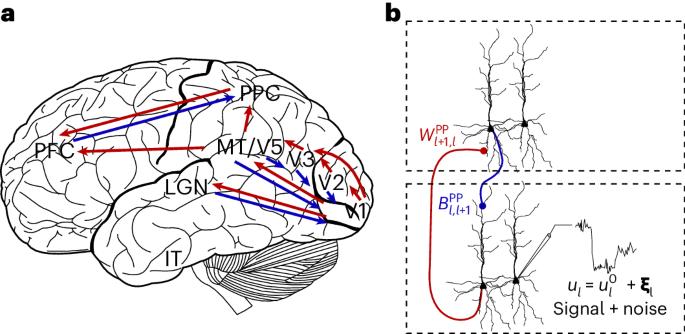Learning efficient backprojections across cortical hierarchies in real time
IF 18.8
1区 计算机科学
Q1 COMPUTER SCIENCE, ARTIFICIAL INTELLIGENCE
引用次数: 0
Abstract
Models of sensory processing and learning in the cortex need to efficiently assign credit to synapses in all areas. In deep learning, a known solution is error backpropagation, which requires biologically implausible weight transport from feed-forwards to feedback paths. We introduce phaseless alignment learning, a bio-plausible method to learn efficient feedback weights in layered cortical hierarchies. This is achieved by exploiting the noise naturally found in biophysical systems as an additional carrier of information. In our dynamical system, all weights are learned simultaneously with always-on plasticity and using only information locally available to the synapses. Our method is completely phase-free (no forwards and backwards passes or phased learning) and allows for efficient error propagation across multi-layer cortical hierarchies, while maintaining biologically plausible signal transport and learning. Our method is applicable to a wide class of models and improves on previously known biologically plausible ways of credit assignment: compared to random synaptic feedback, it can solve complex tasks with fewer neurons and learn more useful latent representations. We demonstrate this on various classification tasks using a cortical microcircuit model with prospective coding. The credit assignment problem involves assigning credit to synapses in a neural network so that weights are updated appropriately and the circuit learns. Max et al. developed an efficient solution to the weight transport problem in networks of biophysical neurons. The method exploits noise as an information carrier and enables networks to learn to solve a task efficiently.


实时学习大脑皮层中的高效反向推演
大脑皮层的感官处理和学习模型需要有效地为所有区域的突触分配信用。在深度学习中,一种已知的解决方案是误差反向传播,这需要从前馈到反馈路径的生物学上难以置信的权重传输。我们引入了无相位对齐学习,这是一种在分层皮层中学习高效反馈权重的生物拟合方法。这是通过利用生物物理系统中自然存在的噪声作为额外的信息载体来实现的。在我们的动态系统中,所有权重的学习都是同时进行的,具有始终开启的可塑性,并且只使用突触局部可用的信息。我们的方法完全无阶段性(无前后传递或阶段性学习),允许在多层皮质层次结构中进行高效的误差传播,同时保持生物学上合理的信号传输和学习。我们的方法适用于各类模型,并改进了之前已知的生物学上合理的信用分配方式:与随机突触反馈相比,它能用更少的神经元解决复杂的任务,并学习到更有用的潜在表征。我们利用具有前瞻性编码的皮层微电路模型,在各种分类任务中证明了这一点。
本文章由计算机程序翻译,如有差异,请以英文原文为准。
求助全文
约1分钟内获得全文
求助全文
来源期刊

Nature Machine Intelligence
Multiple-
CiteScore
36.90
自引率
2.10%
发文量
127
期刊介绍:
Nature Machine Intelligence is a distinguished publication that presents original research and reviews on various topics in machine learning, robotics, and AI. Our focus extends beyond these fields, exploring their profound impact on other scientific disciplines, as well as societal and industrial aspects. We recognize limitless possibilities wherein machine intelligence can augment human capabilities and knowledge in domains like scientific exploration, healthcare, medical diagnostics, and the creation of safe and sustainable cities, transportation, and agriculture. Simultaneously, we acknowledge the emergence of ethical, social, and legal concerns due to the rapid pace of advancements.
To foster interdisciplinary discussions on these far-reaching implications, Nature Machine Intelligence serves as a platform for dialogue facilitated through Comments, News Features, News & Views articles, and Correspondence. Our goal is to encourage a comprehensive examination of these subjects.
Similar to all Nature-branded journals, Nature Machine Intelligence operates under the guidance of a team of skilled editors. We adhere to a fair and rigorous peer-review process, ensuring high standards of copy-editing and production, swift publication, and editorial independence.
 求助内容:
求助内容: 应助结果提醒方式:
应助结果提醒方式:


